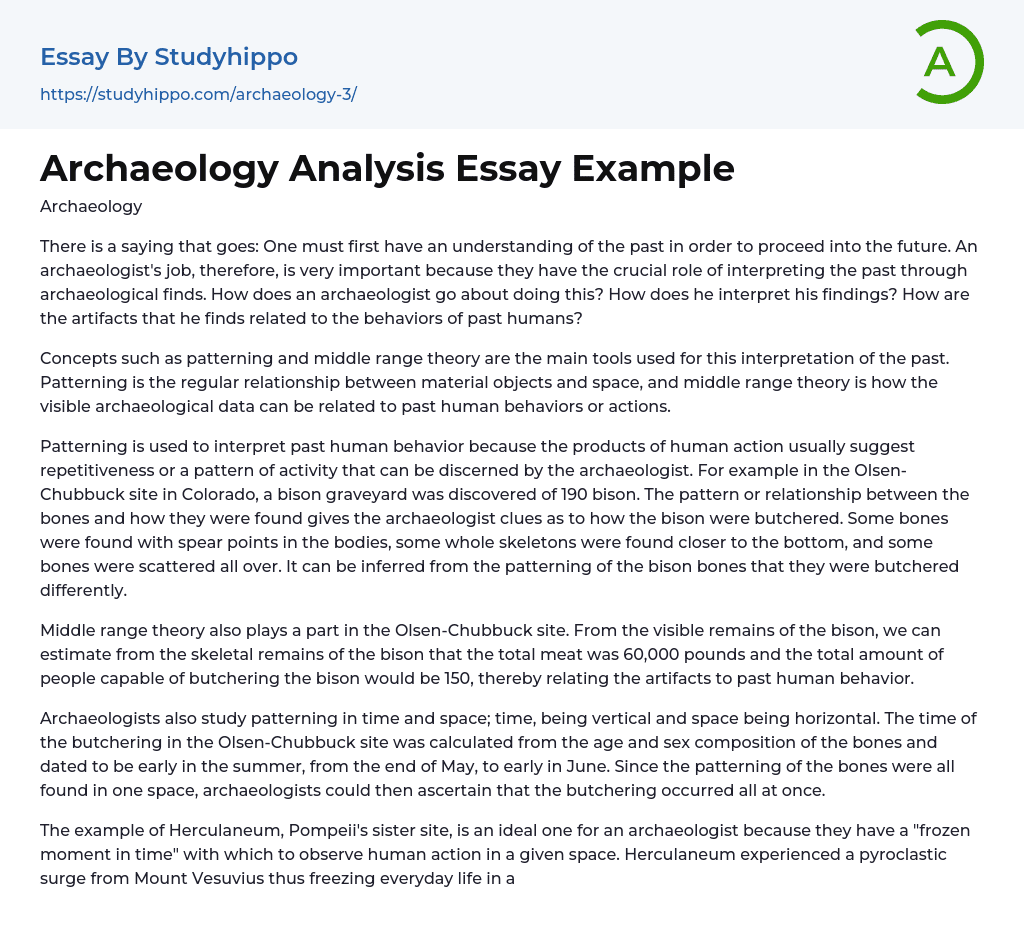Archaeology
There is a saying that goes: One must first have an understanding of the past in order to proceed into the future. An archaeologist's job, therefore, is very important because they have the crucial role of interpreting the past through archaeological finds. How does an archaeologist go about doing this? How does he interpret his findings? How are the artifacts that he finds related to the behaviors of past humans?
Concepts such as patterning and middle range theory are the main tools used for this interpretation of the past. Patterning is the regular relationship between material objects and space, and middle range theory is how the visible archaeological data can be related to past human behaviors or actions.
Patterning is used to interpret past human behavior because the products of human action usually
...suggest repetitiveness or a pattern of activity that can be discerned by the archaeologist. For example in the Olsen-Chubbuck site in Colorado, a bison graveyard was discovered of 190 bison. The pattern or relationship between the bones and how they were found gives the archaeologist clues as to how the bison were butchered. Some bones were found with spear points in the bodies, some whole skeletons were found closer to the bottom, and some bones were scattered all over. It can be inferred from the patterning of the bison bones that they were butchered differently.
Middle range theory also plays a part in the Olsen-Chubbuck site. From the visible remains of the bison, we can estimate from the skeletal remains of the bison that the total meat was 60,000 pounds and the total amount of people capable of butchering the bison woul
be 150, thereby relating the artifacts to past human behavior.
Archaeologists also study patterning in time and space; time, being vertical and space being horizontal. The time of the butchering in the Olsen-Chubbuck site was calculated from the age and sex composition of the bones and dated to be early in the summer, from the end of May, to early in June. Since the patterning of the bones were all found in one space, archaeologists could then ascertain that the butchering occurred all at once.
The example of Herculaneum, Pompeii's sister site, is an ideal one for an archaeologist because they have a "frozen moment in time" with which to observe human action in a given space. Herculaneum experienced a pyroclastic surge from Mount Vesuvius thus freezing everyday life in a split second. The patterning of all the artifacts covered under pyroclastic flow and the condition in which they were found help explain the final moments of Herculaneum. The concrete-like hard material preserved many artifacts such as a baby's crib, a bowl of fruit and loaf of bread, even skeletal remains.
The pyroclastic surge was a natural formation process that affected the patterning of Herculaneum because it resulted from the action of nature. Three things determine natural formation processes: First, the nature of the climate must either be dry or cold, but not wet and the condition must remain constant. Second, the nature of the deposit is preferred when the conditions are not variable such as when they are waterlogged, frozen, or arid. Last, the nature of materials is important in preservation of artifacts. Artifacts such as ceramics or lithics preserve in all deposits, bone and
copper preserve in most deposits, but wood, cloth, and paper preserve in only the best deposits. Cultural formation processes as well can affect the patterning of the archaeological record. There are three types of deposits found in cultural formation processes. Defacto, the first, is when there is a catastrophic abandonment. It is preferred by archaeologists because they find artifacts exactly as they were up to the point of abandonment. Primary, the second, is desirable as well, but is when the materials are deposited at the point of use. Secondary, the least desirable to an archaeologist, is when the materials are deposited away from the point of use. An example of a cultural formation process is the way in which food is collected (hunting). Certain things can be inferred from these processes and more data can be gathered from them. In the case of Herculaneum, the surge charred all wooden objects and was followed by a pyroclastic flow. Middle range theory is very important in this case because all of the artifacts that were buried under the pyroclastic material display the past human behavior and their everyday existence. Things such as food, a baby crib, and art, which depict the day to day lives of the inhabitants of Herculaneum, were found.
The job of an archaeologist is continuous and will never end. With the use of patterning and middle range theory, archaeologists help interpret the past through their findings. As of yet, we do not have a complete understanding of the past, but we are surely on the path to the future.
- Agriculture essays
- Albert einstein essays
- Animals essays
- Archaeology essays
- Bear essays
- Biology essays
- Birds essays
- Butterfly essays
- Cat essays
- Charles Darwin essays
- Chemistry essays
- Dinosaur essays
- Discovery essays
- Dolphin essays
- Elephant essays
- Eli Whitney essays
- Environmental Science essays
- Evolution essays
- Fish essays
- Genetics essays
- Horse essays
- Human Evolution essays
- Isaac Newton essays
- Journal essays
- Linguistics essays
- Lion essays
- Logic essays
- Mars essays
- Methodology essays
- Mineralogy essays
- Monkey essays
- Moon essays
- Mythology essays
- Noam Chomsky essays
- Physics essays
- Plate Tectonics essays
- Progress essays
- Reaction Rate essays
- Roman Numerals essays
- Scientific essays
- Scientific Method essays
- Scientist essays
- Seismology essays
- Space Exploration essays
- Stars essays
- Sun essays
- Thomas Edison essays
- Tiger essays
- Time Travel essays
- Universe essays




